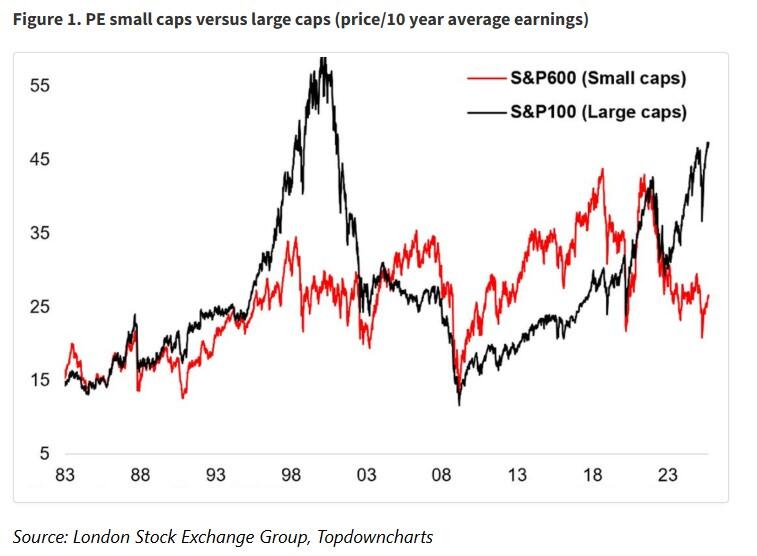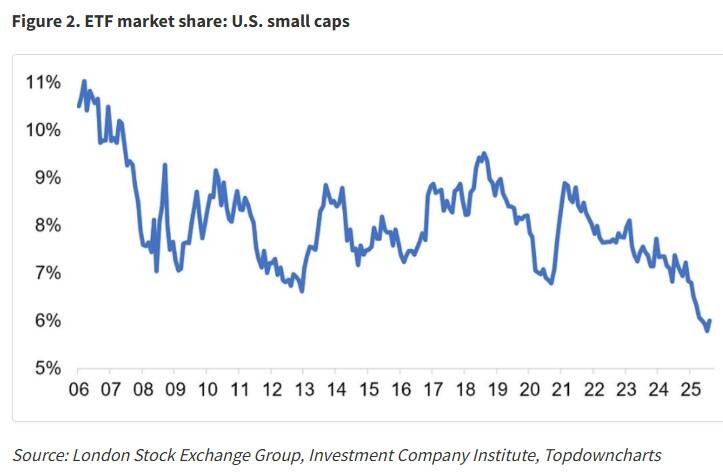While small cap stocks on the ASX account for 87% of all listed stocks, they do precious little to move the market on any given day; with the difference between the All Ordinaries Index and the ASX300 Index accounting for 336 points - that’s a measly 3.68% of total market movement (based on today’s numbers).
While small cap stocks significantly outpaced the tech-fuelled S&P 500 Index during the post-pandemic bull market ending in December 2021, the sector has for a long time played second fiddle to the global onslaught of tech stocks and, more recently, artificial intelligence.
Since then, it’s AI-tech darlings that have shanghaied the media narrative that has driven capital flows into these immensely popular stocks.
Value and contrarian appeal
However, for investors willing to do their own homework, the small cap landscape offers a veritable treasure trove of value and contrarian appeal, that’s lurking behind the hype of large-cap stocks that command the market’s attention both locally and overseas.
Sentiment towards ASX-listed small caps has been progressively turning since the sector slumped to a five-year low in late October 2023.
A closer look at the ASX Small Ordinaries Chart, which represents the small-cap component of the ASX – accounting for around 12% of the total equity market – shows that small caps have been on a tear since April this year.
Year to date, the ASX Small Ordinaries index is up 20.45%, while the ASX200 Index and the All Ordinaries Index are up 7.40% and 7.37% respectively.
US small caps
While small-cap stocks in the United States have lagged their ASX counterparts, there’s growing speculation that they may now be one of the more intriguing opportunities in today’s market.
Compared to large caps, small companies have been trading at a significant discount for some time, with price to earnings (PE) ratios reminiscent of the lows seen during the 2020 Covid market trough.
Small caps also look relatively cheap compared to their historic long-term averages.
When compared to bonds, U.S. small caps still offer a healthy equity risk premium, making them a relatively compelling choice for value-conscious investors (see table below).

Why now?
According to Roger Montgomery, Founder and Chairman of Montgomery Investment Management, it’s the current low investor sentiment toward small caps, notably the hugely overlooked U.S variety, that makes them worth investigating right now.
Montgomery believes the massive outflows witnessed by small cap equity funds this year creates a fertile hunting ground for contrarians to sniff out compelling value plays.
“Meanwhile, futures markets show near-record short positioning, setting the stage for a potential short squeeze if sentiment shifts,” says Montgomery.
He reminds investors of the old adage to ‘be greedy when others are fearful’.
It could be that there is sufficient relative negative sentiment (or just too much enthusiasm for mega caps) that the stage is set for small caps to outperform.

Small caps ignored
The above table reveals assets under management in small-cap exchange-traded funds (ETFs) as a percentage of all U.S. domestic equity ETFs.
While the low level is a function not only of flows into large-cap ETFs but also of the price performance of large caps – led by Nvidia and its peers – it also reveals how much small caps are being overlooked by large caps.
One explanation could be that in a world of winner-take-all monopolistic mega-caps, small companies are dismissed as unlikely to win in business.
But what this thinking overlooks, adds Montgomery, is the potential pace of earnings growth for individual small companies that are expanding from a small base.
“And when it comes to big caps, let’s not forget the law of large numbers; Mega caps cannot keep growing at double-digit rates indefinitely, lest they become…well…earth,” says Montgomery.
Small cap sentiment is thawing
Nevertheless, recent data that shows a slight uptick in small-cap ETF allocations suggests that sentiment towards U.S. small caps is starting to thaw.
Montgomery also reminds investors that when an asset class falls out of favour for an extended period of time and then begins to see renewed interest, it can portend a change of trend.
“In this case, a shift in sentiment towards small companies and maybe away from Mega caps,” he ponders.
Favourable macro tailwinds
Meanwhile, the macroeconomic stars appear to be colliding into a favourable constellation for small caps.
One strong indicator is the U.S central bank, the Federal Reserve (The Fed), which is currently on the cusp of a new round of interest rate cuts.
Investors should need no reminding that small caps – often more sensitive to borrowing costs – could be key beneficiaries of this outcome.
Lower interest rates could ease financial pressures on some of these small caps, many of which rely on debt to fuel growth,” adds Montgomery.
Interestingly, small caps could also thrive in a scenario where global growth picks up.
“Unlike large-cap indices, which are heavily weighted toward tech, small-cap indices are also packed with traditional cyclical sectors like industrials and consumer goods,” says Montgomery.
“These sectors tend to outperform when economic growth accelerates.”
Gnarly downside?
Given that a U.S. recession remains a threat, with the Fed struggling to keep the inflation genie well and truly corked, a deep downturn could drag absolute returns lower, and small caps would be no exception.
However, Montgomery suspects that even in a bearish scenario, small caps might hold their own better than their larger counterparts.
Montgomery argues that large caps, particularly in tech and AI-driven sectors, are grappling with stretched valuations, speculative froth and even possible irrational exuberance.
“In a market correction, the AI high-flyers could fall harder, potentially resulting in small caps outperforming on a relative basis,” he notes.
“On the flip side, a short and shallow recession with aggressive rate cuts and fiscal stimulus could actually be a net positive for small caps, further boosting their appeal.”
Meanwhile, regardless of how markets turn, investors can take some comfort knowing that small cap stocks are at an intriguing inflection point.
In addition to being historically cheap relative to large caps and bonds, they’re under-owned, with investor sentiment just beginning to shift.
With macroeconomic factors now aligning, and earnings revisions appearing to be turning up, now could be the time to take intelligent bets on a U.S. small cap revival.


